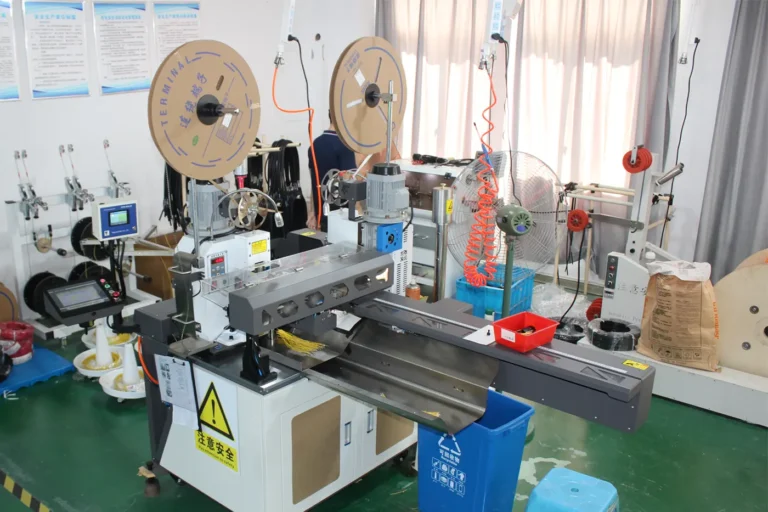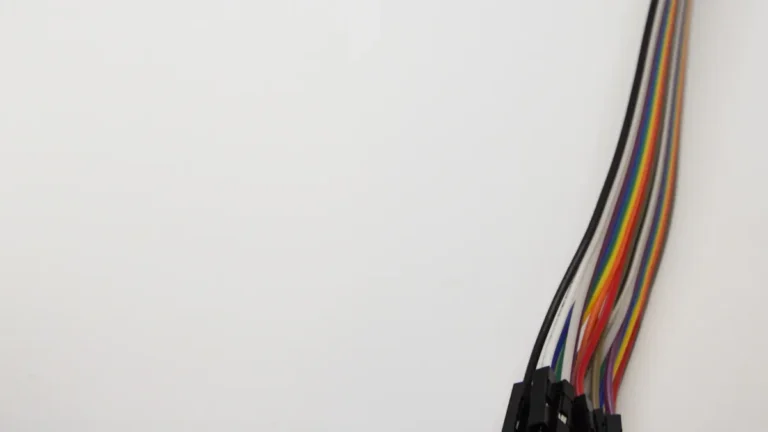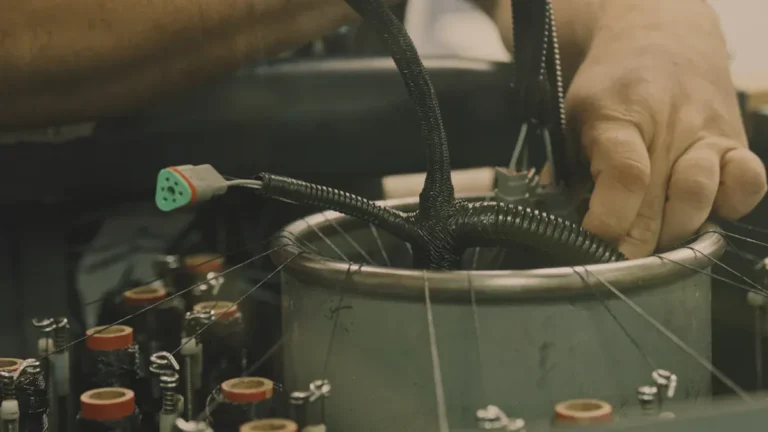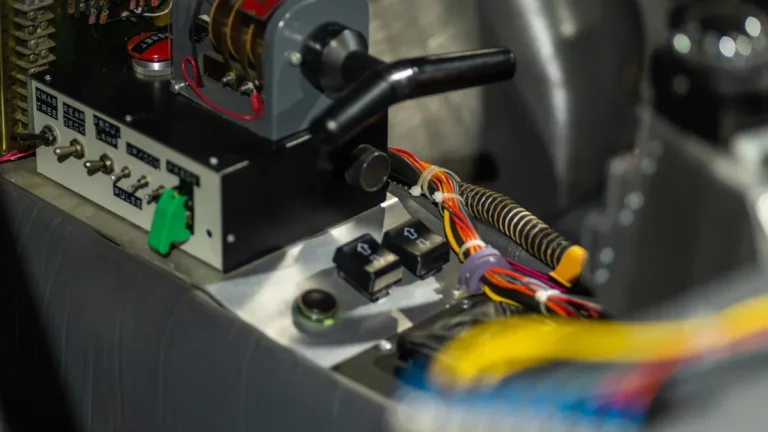Common Materials Used in Car Wire Harnesses

Car wire harnesses use many materials to work well and stay safe. These materials are copper, aluminum, PVC, XLPE, Teflon, nylon, and different metals and plastics for connectors.
Material | Market Position | Key Characteristics and Trends |
|---|---|---|
Copper | Great at carrying electricity, bends easily, and is very reliable. It is used a lot in wiring harnesses for many things. | |
Aluminum | Fastest-Growing | Light in weight and saves money. It is popular in new energy cars and modern designs. |
Copper-based alloys | Emerging substitution | Makes wires lighter and cheaper but still keeps good features for car wiring harnesses. |
The materials you pick change how the wiring harness works and lasts. Copper wires let electricity flow very well. Insulation like PVC and polyethylene keep wires safe from heat and water. Newer materials and coatings help wires last longer, weigh less, and work with smart car features. Picking the right materials keeps cars safe, reliable, and up to standard.
Key Takeaways
Copper is used a lot in car wire harnesses. It carries electricity very well. It bends without breaking. It also lasts a long time.
Aluminum is lighter than copper. It costs less too. Many new energy cars use aluminum. But aluminum wires must be thicker. They also need more protection.
Insulation materials like PVC, XLPE, and Teflon cover the wires. They keep wires safe from heat and chemicals. They also stop damage. This helps harnesses last longer.
Good shielding and sleeves protect the wires. They block electrical noise. They also stop wires from getting hurt. This keeps harnesses safe and working well.
Picking the right materials is important. Following safety rules helps too. This makes harnesses work better and last longer. It also helps cars stay safe and clean.
Conductors in Car Wire Harnesses

Copper
Copper is the most common conductor in car wiring harnesses. It lets electricity move through wires very easily. Copper wires are strong, bend well, and last a long time. These qualities help copper wires work even when cars shake or get hot or cold.
Copper is important in car design. It sends power, data, and signals to many car parts. Most car wiring harnesses use copper because it keeps the system working well. Copper costs more than some other metals, but it works about twice as well as aluminum. Copper wires also need less covering, so harnesses stay light and simple to put in.
Car makers pick copper for flexible harnesses. These harnesses must bend and fit into small spaces. Copper bends easily, so it is great for these jobs. Some new harnesses use copper-tin alloy cables. These cables are lighter and smaller but still strong. This helps cars work better and cost less.
Tip: Copper is only about 1% of a car’s weight, but it is still very important. Since cars were first made, copper has been needed for safe and good electrical systems.
Aluminum
Aluminum is a fast-growing choice for car wiring harnesses. It weighs less than copper, so cars can be lighter. Lighter cars use less gas and make less pollution. Aluminum also costs less, so it is good for big wiring projects.
But aluminum wires must be thicker to carry the same electricity as copper. They also need more covering and protection. These extra needs can make aluminum less cheap. Still, many electric and new energy cars use aluminum harnesses to save weight and meet new designs.
Aluminum is good for high voltage jobs, like electric car batteries. Its light weight and good conductivity make it fit for these uses. Car makers use aluminum in main power cables and other places where weight matters most.
Composite and Specialty Conductors
Some car wiring harnesses use composite or special conductors. These mix the best parts of different metals. For example, copper-clad aluminum wires have an aluminum center and a thin copper layer outside. This makes the wire conduct well, bend easily, and stay light and cheap.
Special metals like gold and nickel are used in advanced car parts. Gold does not rust and keeps good connections in sensitive spots. Nickel can handle high heat, so it is used near engines or hot places. These special conductors help cars work better and last longer.
Composite and special conductors help with new trends in car wiring harnesses. They let car makers meet tough safety and environmental rules. By picking the right metals, engineers make harnesses that work in many ways.
Note: The conductor material changes how well, how safe, and how much a car wiring harness costs. Top companies like Yueqing Chengli Electronic Technology Co., Ltd. use new materials and smart designs to make great wiring harnesses for all cars.
Insulation and Jacketing Materials

Insulation keeps car wiring harnesses safe from heat and chemicals. It also protects wires from getting scratched. Good insulation helps cars last longer and work better. Most car wire insulation uses thermoplastic materials. These are light, bend easily, and can be shaped. They also do not get damaged by heat or chemicals.
Some common thermoplastic insulation and jacketing materials are:
PVC (Polyvinyl Chloride)
Polyethylene (PE)
Polypropylene (PP)
Polyurethane (PU)
Polyphenylene ether (PPE)
Nylon
Thermoset materials like XLPE, rubber, and silicone are used in some harnesses. Thermoplastics are still popular. They help make cars lighter and save energy.
PVC (Polyvinyl Chloride)
PVC is a very common insulation for car wires. It bends easily and is simple to put on wires. PVC works well in normal temperatures. It also stands up to acids and alkalis. But, PVC can break down if it gets too hot for a long time. It does not cost much, so many cables use it.
Property | PVC (Polyvinyl Chloride) |
|---|---|
Thermal Stability | Up to 105°C |
Chemical Resistance | Good against acids/alkalis |
Flexibility | High |
Electrical Insulation | Good |
Cost | Low |
XLPE (Cross-linked Polyethylene)
XLPE is a thermoset material that protects better than PVC. It can handle higher heat and does not give off bad gases when hot. XLPE stands up to oils, solvents, and chemicals. This makes it good for tough car jobs. XLPE keeps its shape and strength even when hot.
Property | XLPE (Cross-Linked Polyethylene) |
|---|---|
Thermal Stability | |
Chemical Resistance | Excellent |
Flexibility | Moderate |
Electrical Insulation | Very Good |
Cost | Moderate |
Teflon and Fluoropolymers
Teflon, also called PTFE, is a special insulation for high-performance wires. It can take very high heat and almost any chemical. Teflon gives great electrical insulation. It works well near engines or in electric cars. Teflon costs more but gives the best protection.
Property | PTFE (Teflon) |
|---|---|
Thermal Stability | |
Chemical Resistance | Excellent |
Flexibility | Lower at room temperature |
Electrical Insulation | Superior |
Cost | High |
Nylon, Polyester, and Other Protective Sleeves
Protective sleeves give extra safety to car wiring harnesses. Nylon sleeves are light, bendy, and stop scratches and water. Polyester sleeves protect from heat, chemicals, and damage. Both types help stop cracks and water damage. This makes cables last longer and work better.
Protective Sleeve | Key Properties | Role in Automotive Applications |
|---|---|---|
Nylon | Lightweight, flexible, abrasion/moisture resistant | Prevents wear, water damage, and functional failures |
Polyester | Abrasion, thermal, and chemical resistant | Shields from fluids, heat, and corrosion; extends cable lifespan |
Protective sleeves and corrugated pipes help wiring harnesses last longer, even in tough car conditions.
Shielding and Protection in Automotive Wiring Harness
Car wiring harnesses need strong shielding and protection. Shielding stops unwanted electrical noise, like EMI or RFI. This noise can mess up a car’s electrical system. Good protection also keeps wires safe from harm, heat, and chemicals. These things help wiring harnesses last longer and work better in many uses.
Metal Braids and Foil Shields
Metal braids and foil shields are very important in car wiring harnesses. They stop outside electrical signals from causing problems. These shields also protect the car’s own signals. Many harnesses use braided copper or aluminum shields. These shields bend easily and last a long time. Foil shields, made with metal-coated Mylar, give even more protection.
Shielding Type | Shielding Effectiveness | Key Characteristics and Notes |
|---|---|---|
Braided Shield | Effectiveness depends on how many wires, wire size, weave angle, and coverage (up to 97%) | |
Spiral Shield | Up to 98% | Shields better than braided, but is less bendy |
Metal-coated Mylar (Foil) | 100% EMI deflection | Blocks almost all EMI; when used with braided shields, covers gaps for the best protection |
Braided shields are flexible and strong. They work well in moving parts and small spaces. Foil shields block almost all EMI, so they are great for sensitive electronics. Some harnesses use both types together for the best results. This keeps car wiring harnesses safe in many different uses.
Note: Good shielding design helps stop cable failure in tough car conditions.
Protective Tubing and Corrugated Pipes
Protective tubing and corrugated pipes cover and protect the wiring harness. These materials keep wires safe from wear, heat, and chemicals. Polypropylene (PP), nylon (PA), and polypropylene modified (PPMOD) are the most common materials for these pipes. Corrugated pipes cover about 60% of wiring harness spots. They are very flexible and can handle temperatures from -40 to 150°C.
Nylon pipes give extra flame resistance and protect from wear. Polypropylene pipes resist bending over and over, so they are good for moving parts. Heat shrink tubing, made from PVC, cross-linked polyolefin, or PET, is also used a lot. It protects branch points and less harsh areas. These protective solutions help car wiring harnesses stay safe and work well in all kinds of uses.
Connectors and Terminals for Wiring Harness
Connectors and terminals are very important in wiring harnesses. They link wires, cables, and devices together. This lets electricity move safely and reliably. The materials used for these parts change how well the harness works. This is extra important in tough car conditions.
Metal Connectors (Copper, Brass, Tin-Plated)
Car connectors often use copper, brass, or tin-plated metals. Each metal has its own good points for the harness.
Copper connectors let electricity flow very well. They help wires carry power quickly and easily.
Brass is made from copper and zinc. It also carries electricity well. Brass does not rust easily. It can handle wet, humid, and harsh places. Different brass types mix strength and conductivity. Brass is cheap and easy to shape. This makes it good for tricky connector shapes.
Tin-plated copper connectors have two good things. The copper inside carries electricity well. The tin on the outside stops rust and damage. These connectors are great for batteries and ground wires. The thick tin layer keeps them safe from harm.
Tip: Picking the right metal connectors stops signal loss. It helps the harness work even when things get rough.
Plastic Housings (PA6, PA66, PP, ABS, PBT)
Plastic housings cover and protect the metal parts inside connectors. They keep out dirt, water, and chemicals. They also help stop fires. Common plastics for car connectors are PA6, PA66, PP, ABS, and PBT.
Plastic Type | Key Properties | Typical Use in Wiring Harness |
|---|---|---|
PA6/PA66 | Strong, stops fire | Connector housings |
PP | Resists chemicals, light | Protective covers |
ABS | Tough, easy to shape | Sensor connectors |
PBT | Handles heat, keeps its shape | Engine connectors |
Yueqing Chengli Electronic Technology Co., Ltd. uses these strong plastics for their connectors. Their products meet strict safety and quality rules. This means every harness stays safe and works well, even in hard car jobs.
Choosing the Right Wiring Harness Materials
Picking the best materials for wiring harnesses is very important. Good choices make cars safer and work better. Engineers have to think about many things. They want the harness to work in all situations.
Performance and Safety Factors
Performance and safety are always important in harness design. Engineers check how each material handles the car’s needs. They want the harness to last and keep people safe.
Use strong wires, connectors, and insulation that can handle heat, shaking, water, and chemicals. This makes the harness last longer and work better.
Pick the right wire size and insulation for the job. Copper and aluminum both carry electricity well. The choice depends on what the harness will do.
Use connectors and terminals that do not rust. This stops problems and keeps the system safe.
Add covers that protect from heat and scratches. This keeps the wires safe from harm.
Make the harness fit small spaces and meet the car’s needs. A good design helps stop problems and makes it easier to put in.
Use the right tools to connect wires. Tight connections help the harness last a long time.
Test the harness with different checks. Testing makes sure it works in real life.
Follow rules like ISO, IATF, UL, and CE. These rules help keep cars safe and good quality.
Factor Category | Key Considerations | Impact on Performance and Safety |
|---|---|---|
Current capacity, voltage, wire gauge, length | Prevents overheating and electrical failures | |
Environmental Conditions | Temperature, moisture, chemicals, vibration | Maintains functionality in harsh conditions |
Mechanical Properties | Flexibility, abrasion resistance, durability | Protects against damage and ensures long-term reliability |
Material Selection | Conductors, insulation, sheathing | Affects conductivity, heat resistance, and protection |
Connector Selection | Type, size, sealing, ease of installation | Ensures secure connections and resists stress |
Design and Routing | Wire gauge, routing, bundling | Reduces voltage drop and mechanical damage |
Standards and Regulations | Compliance with ISO, SAE, UL, CE | Guarantees safety and compatibility |
Testing and Validation | Electrical, mechanical, and environmental testing | Confirms performance and reliability |
Car wiring harnesses must meet tough rules. If engineers pick the wrong materials, the harness might break. Problems can be worn insulation, hot wires, or rusty connectors. These issues can cause shorts, fires, or the car to stop working. To stop these problems, engineers use special car materials and test every harness.
Yueqing Chengli Electronic Technology Co., Ltd. follows these steps. Their harnesses use strong materials and pass hard tests. This means their products are safe and work well everywhere.
Tip: Always pick materials that fit the car’s needs and follow all safety rules. This is the best way to make harnesses last longer and work better.
Cost, Sustainability, and Compliance
Cost, being green, and following rules also matter when picking materials. Engineers must find a balance between price, how well it works, and the environment.
The price of copper and other materials can change fast. Makers sometimes use aluminum or copper-clad aluminum to save money.
Lighter materials help make cars weigh less. This saves gas and helps meet pollution rules.
Being eco-friendly is very important now. Many companies use insulation that can be recycled and solder without lead. They also use machines that save energy and handle waste carefully.
Picking suppliers with green wires and recyclable boxes helps the planet.
Digital systems help track where materials come from. This makes sure all parts are safe for the environment.
Material Category | Examples & Properties |
|---|---|
Conductor Materials | Copper, aluminum, copper-clad aluminum (lightweight, conductive, cost-effective) |
Insulation & Sheathing | PVC (flame retardant), XLPE, silicone, LSZH (low smoke, halogen-free) |
Connector & Terminal Materials | Plastic (PA66, PBT), metal terminals, sealed connectors |
Certifications & Compliance | ISO 9001, IATF 16949, UL, CE, RoHS, REACH |
Testing & Validation | Electrical, mechanical, environmental durability |
Certifications are very important in harness design. Rules like ISO 9001, IATF 16949, UL, and CE show the product is safe and good quality. Many countries need these certifications. They help stop problems like hot wires, shocks, and fires.
Yueqing Chengli Electronic Technology Co., Ltd. is a good example. Their harnesses meet ISO, IATF, UL, and CE rules. They use green materials and make products in a clean way. This helps customers reach their own green goals.
Note: Always look for certifications and green practices when picking a harness supplier. This makes sure the harness is safe, works well, and is good for the earth.
When engineers think about all these things, they make smart choices. Good materials help harnesses last longer and work better. This also helps new ideas and solves problems in car harness design.
Car wire harnesses need different materials to follow car rules. The table below lists the main types and what they do:
Material | Role in Car Wire Harnesses |
|---|---|
Copper | Gives great electrical power and does not rust easily |
Aluminum | Makes the harness lighter and helps wires work well |
Gold/Nickel | Works in hot places inside important wiring harnesses |
Steel/Tin/Zinc | Makes harnesses stronger and stops rust |
Picking good materials for wiring harnesses keeps cars safe and working longer.
Strong harnesses stop heat and damage
Good materials mean less fixing and better trust
Certified makers like Yueqing Chengli Electronic Technology Co., Ltd. make sure harnesses are safe and high quality
FAQ
What is the most common material for car wire harness conductors?
Copper is used in most car wire harnesses. It lets electricity move easily. Copper also bends without breaking. Car makers like copper because it lasts long. It helps keep cars safe for a long time.
Why do some car wire harnesses use aluminum instead of copper?
Aluminum is lighter than copper. Using aluminum makes cars weigh less. Lighter cars use less fuel. Some new cars use aluminum harnesses. This helps with new designs and saves energy.
How do engineers pick insulation for car wiring harnesses?
Engineers think about heat and chemicals. They also check how much wires need to bend. They pick materials like PVC, XLPE, or Teflon. These protect wires from harm and keep cars safe.
Are all wiring harness materials safe for the environment?
Many top companies use green materials. They follow rules like RoHS and REACH. These rules stop bad chemicals from getting into car wiring harnesses.






